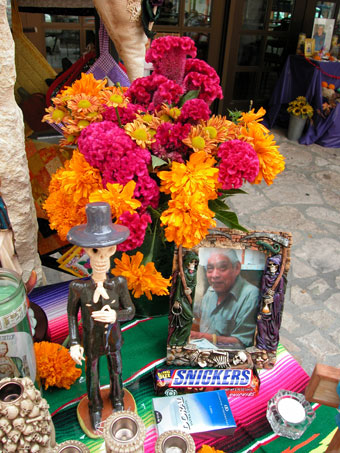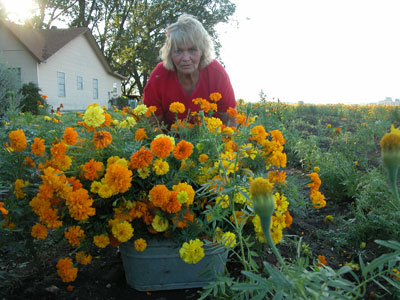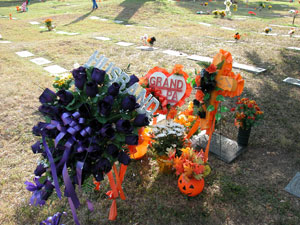Human Flower Project
Monday, October 31, 2005
Cempasuchitl—San Antonio Runs Low
San Antonians are scrambling to find the traditional flower for El Dia de los Muertos.

An ofrenda in the courtyard of San Fernando Cathedral
honors a loved one with marigolds , coxcombs, & candy
Oct. 30, 2005, San Antonio, TX
All souls, departed and contemporary, are on the move this time of year in Texas. Temperatures are bearable at last, and hibernating spirits regain the impulse for festivity.
Today’s is Halloween, of course, but in San Antonio, the pervasive celebrations are for All Saints Day (Nov. 1) and All Souls (Nov. 2), better known as El Dia de los Muertos. We’ve been making a yearly pilgrimage to San Antonio, to visit the flower farmers of The Belgian Gardens, the flower vendors along Castroville Road, and San Fernando II Cemetery, but this year brought some sad awakenings.
The traditional flower for Day of the Dead is a long-stemmed marigold (tagetes erecta L.), known in its native land of Central Mexico as cempasuchitl. That name, from the Aztec dialect Nahuatl, means “twenty petals”—a pre-trade-deficit metaphor for “infinity.”

Carmen Almaguer gathered marigolds at Roger and Patsy Verstuyft’s
farm last year. The Verstuyfts didn’t grow a flower crop in 2005.
Cempasuchitl traditionally decorates the graves on this occasion. Their iridescence and pungent smell are said to guide the spirits of the dead back to earth for an annual communion with the living. (Cempasuchitl, we learned, is also used in the manufacture of yellow dye; it’s added to chicken feed to make skins and yolks more appealingly yellow.)
Jo Tuckman wrote a piece for the Houston Chronicle in 2002 about how more compact, hybrid marigolds, grown from seed genetically engineered in the U.S. have been gradually usurping the All Souls market. Flowers with shorter stems tend to be popular with shippers and some growers, since their stems are less prone to breaking during the “pilgrimage” from field to vase. But in San Antonio, the problem this year was finding any marigolds at all.
Craig Pennel, whose Tienda Guadalupe always arranges a big ofrenda (altar) in memory of Pennel’s partner Danny Lozano, “had to buy from a florist this year,” since the vendors along Castroville Road had no marigolds to sell. Local farmers Patsy and Roger Verstuyft on Somerset Road may have grown their last crop of Day of the Dead flowers; Patsy’s had shoulder surgery and Roger’s back is giving him the dickens. Their children, with health woes of their own, don’t seem to be taking over the long family tradition.
Relatives Eunice and Mark Verstuyft, who farm just a bit farther south, planted flowers as usual this year but, Eunice said sadly, “They haven’t opened. We don’t know what’s wrong.” By Sunday, October 30, usually a bustling time at their barn in Von Ormy, they’d only cut two dozen marigold bunches. Local growers have it hard, but in parts of Mexico, recent hurricanes have completely swamped thousands of acres of farmland; Mexican marigolds have been hard to come by, too.
 A memorial at San Fernando II Cemetery
A memorial at San Fernando II Cemetery
San Antonio, TX, October 2005
The flower vendors, now required to pay the city a whopping $180 fee to sell on the street, still were doing a fairly steady business yesterday, as people stopped for decorated cans of real gladiolas and easels of silk roses. Maria Orta, who with her mother Carmen Alamguer is a regular flower seller at the Las Palmas shopping center across from San Fernando II Cemetery, said business was down. “People want the marigolds,” she said, and there just aren’t any to sell.
Culture & Society • Cut-Flower Trade • Florists • Religious Rituals • Permalink




